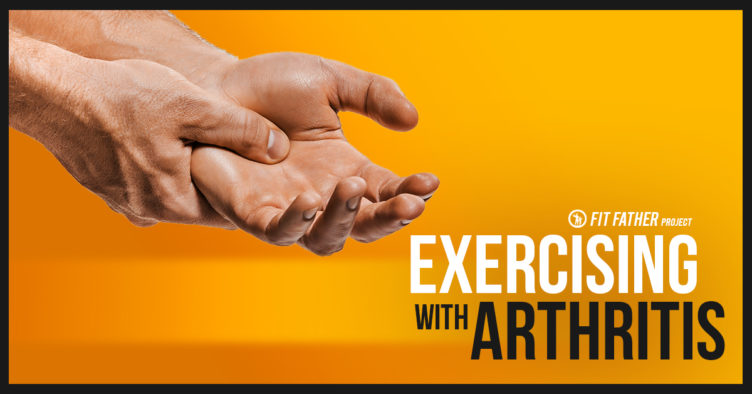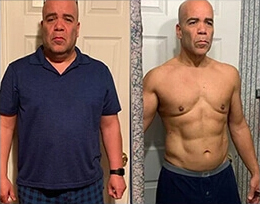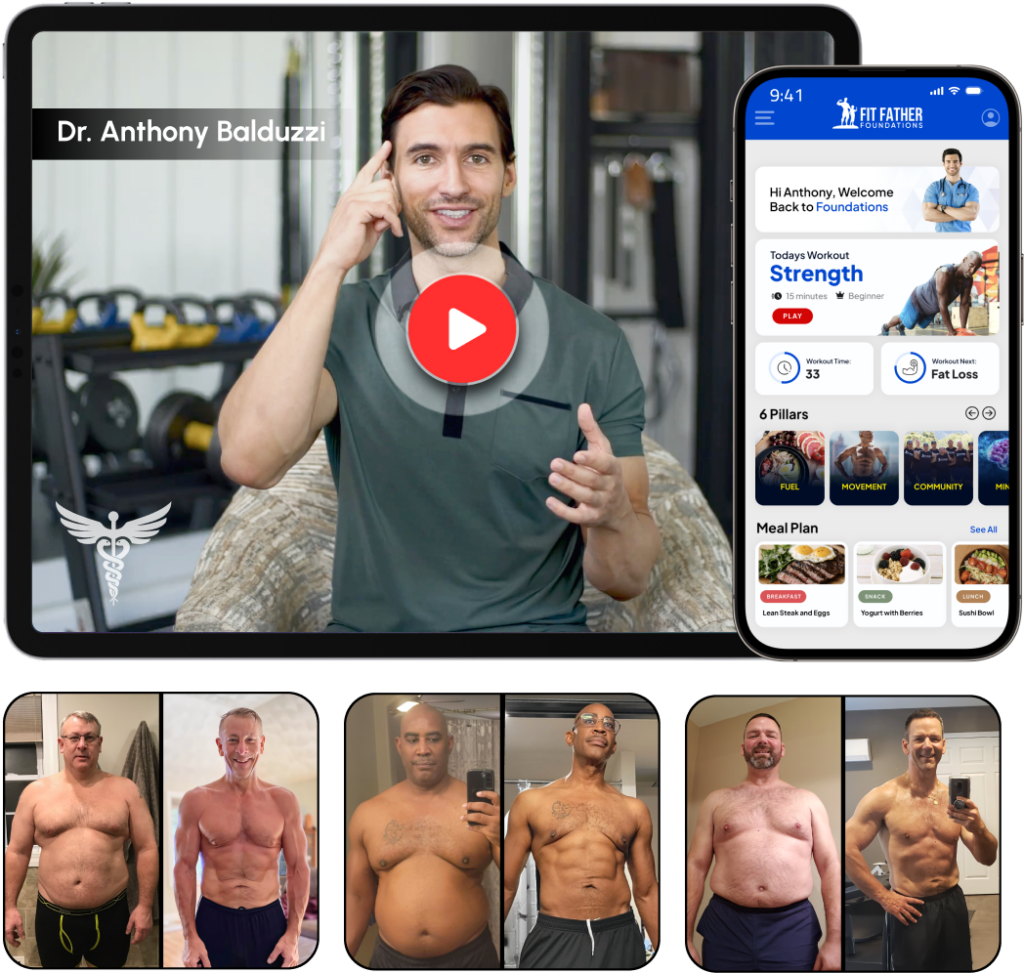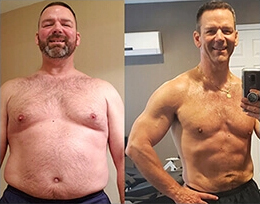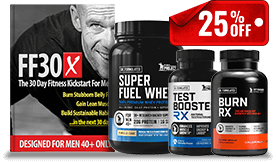Think exercising with arthritis is just a pipe dream? Think your best fitness days are behind you? Think again!
Yes, achy, creaky joints seem to come with the territory of getting older.
Years of hard work and physical activity put a lot of strain on your joints and can lead to arthritis and stiffness over time.
But this doesn’t mean you have to give up on a healthy and active lifestyle!
While arthritis may be inevitable, there are a number of ways to improve your joint pain and stiffness so that you can continue living a high quality of life.
This includes specific exercises, stretches, and nutrition changes to help arthritis sufferers.
Keep reading to learn about exercising with arthritis and how to do it safely and effectively.
Got back and knee pain? Here's how to get the relief you need!
Meet Joint RX. The Advanced Joint Support, Recovery Aid, Inflammation & Pain Reducer for Men 40+
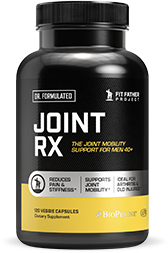
The Ultimate Guide to Exercising With Arthritis
Exercising with arthritis isn't a myth! Exercise is actually a critical part of managing arthritis.
While it may seem counterintuitive to increase activity when your body feels achy, the right workouts can actually help ease the symptoms of arthritis.
For example, in clinical trials, both aerobic and strength training have been shown to reduce pain and improve physical function in people with knee osteoarthritis.
While physical activity can improve the symptoms of arthritis, you have to make sure you are picking the right exercises.
When exercising with arthritis, anything that really stresses your joints should be limited or avoided.
The most common culprits here are plyometrics and high impact moves that involve a lot of jumping and pounding on your joints.
This doesn’t mean that you can do high-intensity workouts, however.
There are tons of low impact moves that can be incorporated into your workouts that can keep your joints healthy.
Swimming
If you have arthritis or joint pain, activities like running can worsen these symptoms.
Swimming is a great low impact activity.
Since water is 800 times denser than air, you will build strength in your muscles and bones and reduce joint pain without excessive pounding on the hard ground.
Since swimming is more gentle on your joints, this means you can swim more often without worrying about aggravating knee or hip pain.
This will lead to improved cardiovascular endurance without the high risk of injury.
Join our 6-Week Program...
You'll Gain Health for Life!In just 6-weeks on our FOUNDATIONS Program, you'll transform your health and body, for the rest of your life!
Elliptical Machine
An elliptical machine is a great option to get an awesome endurance workout without the pounding that running creates on your joints.
Plus, most ellipticals require you to use your arms to increase your momentum, so that you are working both your upper and lower body.
This video features practical home remedies to treat joint pain and practical tips on how to reduce it.
Biking
Another low impact activity is biking.
This can be done outdoors, with a home workout bike, or you can even try out a spinning class at your gym.
Yoga
This is an amazing activity for both your body and your mind.
Yoga builds core strength while also improving your balance, flexibility, and coordination.
This is the perfect activity if you have joint pain as the moves are gentle on your joints.
Plus, you can modify any of the poses if you find that it is exacerbating your arthritis symptoms.
The 5 Tibetan Rites yoga routine was created by Tibetan monks to increase youth and vitality!
Low Impact High-Intensity Intervals
When most guys think of high-intensity intervals they picture jump squats and burpees.
Unfortunately, these high impact plyometric moves can do a number on your joints.
However, you can still get in a great HIIT workout without worsening your arthritis symptoms.
Walking
Walking is a great way to improve your health, not only because of the number of health benefits but also because almost anyone can start on a walking program without equipment or training.
Plus, it’s an exercise that is easy on the joints.
The key is to choose moves where your feet stay on, or at least close to, the ground.
Setting up a circuit that involves exercises like push-ups, bear crawls, and side lunges can still get your heart rate up while avoiding high impact on your knees and hips.
Learn about the importance of walking every day and how it can DRASTICALLY improve your overall health.
At Home Stretches
In addition to your regular workouts, stretches to increase your range of motion will also help ease joint pain.
Be sure to warm up before stretching and at a time of day when your joints are less stiff.
You can try some of these stretches at home to improve your flexibility and decrease pain.
Single Knee to Chest Stretch
- Lie on your back and bend both knees.
- Grab your right knee with both hands and gently pull the knee toward your chest.
- You will feel a stretch in the back of your leg and lower back.
- Hold for about 30 seconds and then slowly release.
- Repeat on the left side.
Leg Swings
This is a great stretch to warm up your lower body prior to a workout and to loosen up your knee and hip joints.
- Stand with your feet shoulder-width apart and your hands resting on your hips.
- Shift your weight to your left foot, bending your right knee slightly while lifting your right heel.
- Swing your right leg forward and backward, allowing your right knee to naturally bend and extend throughout the movement.
- Continue for 15-30 seconds, then repeat on the left side.
These stretches for people who sit all day will help combat the negative effects of sitting too much.
Arm Circles
This move will increase the flexibility in your shoulders and is also a good warm-up stretch.
- Stand with your feet hip-width apart and bring your arms out to your sides at shoulder height, palms facing down.
- Circle both arms forward, starting with small circles and then progressing to larger circles.
- Complete 10 small circles and 10 large circles, then reverse direction and circle your arms backward.
Cat-Cow
This classic yoga move will help improve mobility and joint discomfort in your low back.
- Start on all fours, with your wrists aligned below your shoulders and your knees aligned below your hips.
- Keep your spine extended and your toes tucked under.
- Inhale, relax your belly so it moves toward the floor, and gently arch your back, tilting your tailbone and chin toward the ceiling.
- Exhale, gently round your spine, draw your chin toward your chest, and untuck your toes, placing the tops of your feet on the floor.
- Repeat 10 times.
Use this ground-up, post-workout stretch routine to get rid of lactic acid from your muscles after your workouts and help to avoid delayed onset of muscle soreness (DOMS).
Nutrition and Arthritis
If you are suffering from joint pain and trying to remain active, your diet can also play a role in your joint health.
When it comes to alleviating the aches and pain of arthritis, there is no shortage of dietary interventions and supplements that are touted as “the best.”
But what really works?
Since arthritis involves joint degeneration and inflammation in the joint lining, foods that fight inflammation and have high levels of antioxidants may help combat joint pain.
This includes foods like fish, nuts, seeds, fruits, and vegetables.
Some of the best foods studied that aid in arthritis symptoms are:
Fish
Salmon, tuna, sardines, herring, anchovies, scallops, and other cold-water fish are good sources of omega-3 fatty acids.
Both animal and human studies have shown that omega-3 polyunsaturated fatty acids exert beneficial effects on osteoarthritis symptoms and bony abnormalities.
Fruits
Fruits are loaded with antioxidants.
Plus, anthocyanins that are found in fruits like cherries, strawberries, raspberries, blueberries, and blackberries have anti-inflammatory actions.
Vegetables
Leafy green veggies like kale and spinach are packed with antioxidants.
These vegetables can also help reduce inflammatory markers in the blood.
Learn how to read nutrition labels properly and what nutrition facts REALLY mean.
Best Supplements For Joint Pain
Nutritional supplements are also an option when dealing with arthritis and an active lifestyle.
There are a lot of claims out there when it comes to alleviating joint pain, so it can be hard to figure out what really works.
Some of the best-studied supplements for arthritis include glucosamine/chondroitin, fish oil, and turmeric.
While not everyone will get dramatic results by using these supplements, they can be a good add on treatment along with exercise and a healthy diet.
However, all supplements and over the counter medications should be discussed with your doctor before starting.
Glucosamine
Glucosamine is one of the most commonly used supplements for osteoarthritis.
It is an amino sugar that is required for the synthesis of glycoproteins and glycosaminoglycans, which are found in joint fluid.
Glucosamine may have anti-inflammatory effects and is thought to stimulate the metabolism of chondrocytes within the joints.
A meta-analysis of glucosamine trials found that glucosamine significantly reduces pain related to arthritis.
Plus, glucosamine has been safely used in long-term clinical trials, with side effects similar to that of placebo and less than that of NSAIDs, like ibuprofen or naproxen.
Turmeric (Curcumin)
Curcumin is the active ingredient of turmeric that has anti-inflammatory, antioxidant, antimicrobial, antirheumatic activity.
Recent trials and medical evidence show that curcumin supplementation is an effective treatment for osteoarthritis with minimal adverse effects.
S-adenosylmethionine
This supplement, also known as SAMe, has antioxidant properties and, in the joints, provides levels of glutathione peroxidase, an antioxidant enzyme.
Studies have shown that supplementing with SAMe has a more beneficial effect in the long term compared to treatment with nonsteroidal anti-inflammatory drugs (NSAIDs) in patients with osteoarthritis.
Other trials have found that SAMe was equally effective as the NSAIDs and more effective than a placebo for pain and function.
Staying Active With Arthritis
As a Fit Father For Life, you don’t want anything to slow you down when it comes to your health and fitness.
That includes joint pain and arthritis.
Luckily, there are ways to combat achy joints to keep you active and living a high quality of life.
By incorporating exercises that don’t pound on your joints and adding some at-home stretches you can loosen up your joints and increase your range of motion and flexibility.
And, by adding in some antioxidant nutrients and supplements you can also help ease the symptoms of arthritis.
These simple tips and tricks will have you well on your way to exercising with arthritis — at a high level!
Holly is board-certified in nephrology and internal medicine, has a bachelor’s degree in dietetics, and is a certified personal trainer with NASM-PES certification. Holly is a keen runner, triathlete, and fitness and nutrition enthusiast. She has completed four full ironmans, twelve marathons, countless half ironmans, Olympic distance triathlons, half marathons, and numerous other road races. Holly joined the Fit Father Project in May 2019 as a regular writer, contributing articles on health, wellness, exercise, and nutrition.![]()
Holly Smith, M.D., B.S. Dietetics, NASM-PES Certified Trainer
Writer, Fit Father Project
This proven "Old School Muscle Program For Guys 40+" combines the “old school” bodybuilding secrets with the “new school” science… to produce muscle & strength building results fast. Only for guys 40+ who want to build muscle. If you're frustrated with stubborn belly fat, failed diets, and time-consuming workouts, this is the answer you’ve been looking for…Here’s How Busy Guys 40+ Are Building Age-Defying Muscle And Strength… Working Out Just 3 Hours Per Week...
See the Old School Muscle (OSM) Program overview here. You’ll discover how this proven program has helped thousands of guys 40+ pack onage-defying muscle and strength – the smart & sustainable way. »
*Please know that weight loss results & health changes/improvements vary from individual to individual; you may not achieve similar results. Always consult with your doctor before making health decisions. This is not medical advice – simply very well-researched info on exercising with arthritis.

